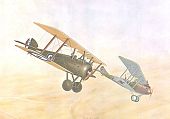SOPWITH F.1 CAMEL
The Sopwith Biplane F. 1 was developed from the Sopwith Pup. It was a snub nosed, hump backed little biplane with staggered single bay wings. Its lower wing had a pronounced dihedral, which contrasted with the flat top wing and accentuated the fuselage hump, which housed the breeches of two Vickers .303 machine guns. This hump was how the F.1 became known as the Camel.
The success of the Camel was due to its outstanding maneuverability which resulted from the concentration of all its masses within a small area of fuselage. The engine, guns, pilot, and fuel were all located within seven feet of fuselage length. The Camel's sensitivity to the controls made it the supreme dog fighting airplane of World War I. More enemy aircraft (1,294) were shot down by the Camel than any other single type aircraft.
The print depicts Camel D9649 which was the aircraft usually flown by David Ingalls. It was one of one hundred built by the firm of Clayton & Shuttleworth.
F. 1 Camel Statistics
Wing span:28'. Length 18' 9". Engine: 130hp Clerget. Maximum Speed: 112 m.p.h. at 10,000ft. Service ceiling: 19,000 ft. Weight Fully Loaded: 1,482 Ibs.

